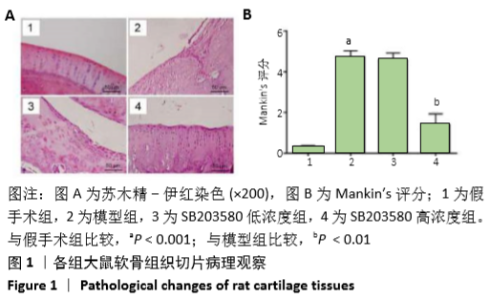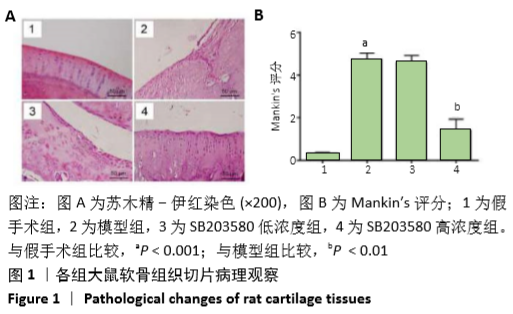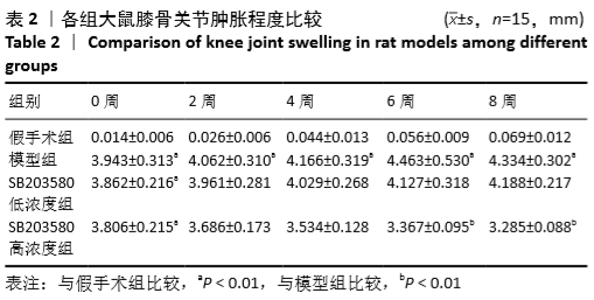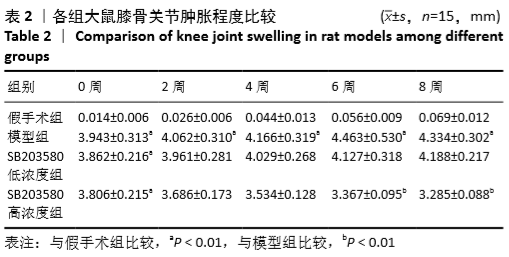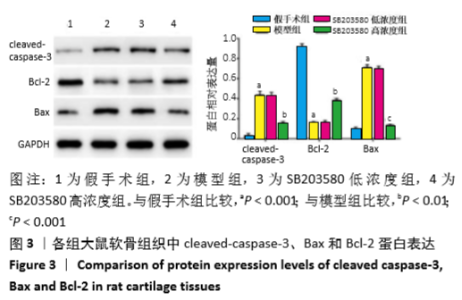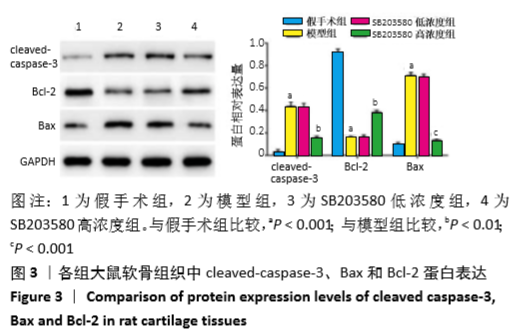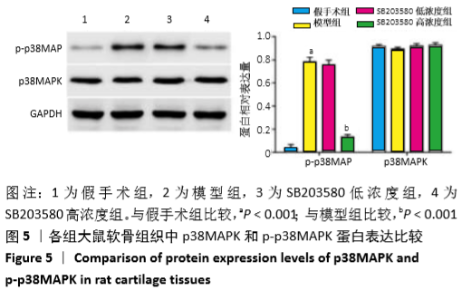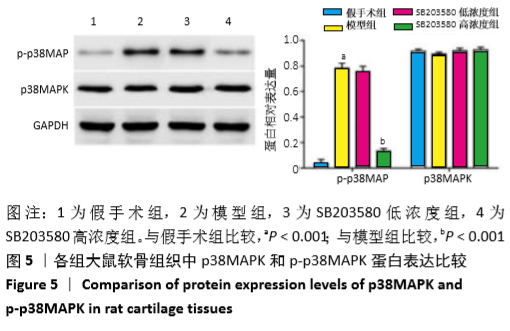[1] 胡静, 李章华. 携带miRNAs的MSCs来源外泌体在软骨退变损伤修复中的研究进展[J]. 医学研究生学报, 2019, 32(12):1312-1317.
[2] LUO Y, ZHANG Y, HUANG Y. Icariin reduces cartilage degeneration in a mouse model of osteoarthritis and is associated with the changes in expression of indian hedgehog and parathyroid hormone-related protein. Med Sci Monit.2018; 24:6695-6706.
[3] GAO H, GUI J, WANG L, et al. Aquaporin 1 contributes to chondrocyte apoptosis in a rat model of osteoarthritis. Int J Mol Med. 2016; 38(6): 1752-1758.
[4] 高航飞, 任戈亮, 徐燕, 等. 骨性关节炎水通道蛋白1的表达与软骨细胞凋亡相关性研究[J]. 中国修复重建外科杂志, 2011, 25(3): 279-284.
[5] WEI X, REN X, JIANG R, et al. Phosphorylation of p38 MAPK mediates aquaporin 9 expression in rat brains during permanent focal cerebral ischaemia. J Mol Histol.2015; 46(3):273-281.
[6] 张重阳,吕喆,王耀辉,等.亚低温通过p38MAPK信号通路调控CPR大鼠脑组织AQP4表达并减轻脑水肿[J].中华危重病急救医学, 2019, 31(4):480-483.
[7] 李姿慧,王键,蔡荣林,等. 参苓白术散通过ERK/p38 MAPK信号通路干预溃疡性结肠炎大鼠结肠组织AQP3、AQP4的表达[J].中成药, 2015, 37(9): 1883-1888.
[8] SHI J, ZHANG C, YI Z, et al. Explore the variation of MMP3, JNK, p38 MAPKs, and autophagy at the early stage of osteoarthritis. IUBMB Life. 2016;68(4):293-302.
[9] 王学宗,丁道芳,薛艳,等. TLR4/NF-κB通路参与大鼠膝骨关节炎滑膜早期病变的研究[J].中国骨伤,2019,32(1):68-71.
[10] WANG Z, ZHENG C, ZHONG Y, et al. Interleukin-17 Can Induce Osteoarthritis in Rabbit Knee Joints Similar to Hulth’s Method. Biomed Res Int. 2017; 2(11):209-215.
[11] 陈俊,林洁,赵忠胜,等. 乌头汤对膝骨关节炎模型大鼠滑膜组织TLR4/ NF-κB信号通路的影响[J].中国组织工程研究, 2019, 23(27): 4381-4386.
[12] TAKUMA M, HARUKA K, MUTSUTO W, et al. Olive leaf extract prevents cartilage degeneration in osteoarthritis of STR/ort mice. Biosci Biotechnol Biochem. 2018; 82(7):1101-1106.
[13] GEORGIEV T, ANGELOV AK. Modifiable risk factors in knee osteoarthritis: treatment implications. Rheumatol Int. 2019; 39(7): 1145‐1157.
[14] TRUJILLO E, GONZÁLEZ T, MARÍN R, et al. Human articular chondrocytes, synoviocytes and synovial microvessels express aquaporin water channels; upregulation of AQP1 in rheumatoid arthritis. Histol Histopathol. 2004; 19(2):435-444.
[15] 田佳,王文雅,张柳. 参与骨关节炎的P38丝裂原活化蛋白激酶信号转导通路[J].中国组织工程研究, 2013, 17(28):5243-5248.
[16] 彭旭, 杨继滨, 尤奇,等. 金骨莲灌胃对兔骨关节炎模型软骨细胞凋亡相关蛋白表达的影响[J].中国组织工程研究, 2020, 24(8): 1188-1194.
[17] TAKANO S, UCHIDA K, ITAKURA M, et al. Transforming growth factor-β stimulates nerve growth factor production in osteoarthritic synovium. BMC Musculoskelet Disord.2019;20(1):204-211.
[18] SUN HY, HU KZ, YIN ZS. Inhibition of the p38-MAPK signaling pathway suppresses the apoptosis and expression of proinflammatory cytokines in human osteoarthritis chondrocytes. Cytokine. 2017; 90:135-143.
[19] JI B, MA Y, WANG H, et al. Activation of the P38/CREB/MMP13 axis is associated with osteoarthritis. Drug Des Devel Ther. 2019; 13: 2195-2204.
[20] PERERA LMB, SEKIGUCHI A, UCHIYAMA A, et al. The Regulation of Skin Fibrosis in Systemic Sclerosis by Extracellular ATP via P2Y2 Purinergic Receptor. J Invest Dermatol.2019;139(4):890-899.
[21] 冯芳芳,于超,谭春江,等.水通道蛋白的表达与关节炎关系的研究进展[J].中国骨与关节杂志, 2015, 4(4):323-327.
[22] 郑世雄,刘合亮,杨巍,等.塞来昔布对骨关节炎大鼠软骨组织AQP1和AQP3表达影响的研究[J]. 风湿病与关节炎, 2019, 8(11):5-10.
[23] 唐进,吉明,徐立新.探讨AQP1、AQP3及IL-1β在膝关节炎滑膜中的表达及意义[J].陕西医学杂志, 2017, 46(12):1749-1750.
[24] LONG DL, LOESER RF. p38gamma mitogen-activated protein kinase suppresses chondrocyte production of MMP-13 in response to catabolic stimulation. Osteoarthritis Cartilage.2010;18(9):1203-1210.
[25] 贺娟娟, 颜春鲁, 安方玉, 等. 炎症因子与炎症因子相关信号通路在膝骨关节炎中的调控机制研究进展[J]. 中国临床药理学杂志, 2019, 35(12):1308 -1311.
|
